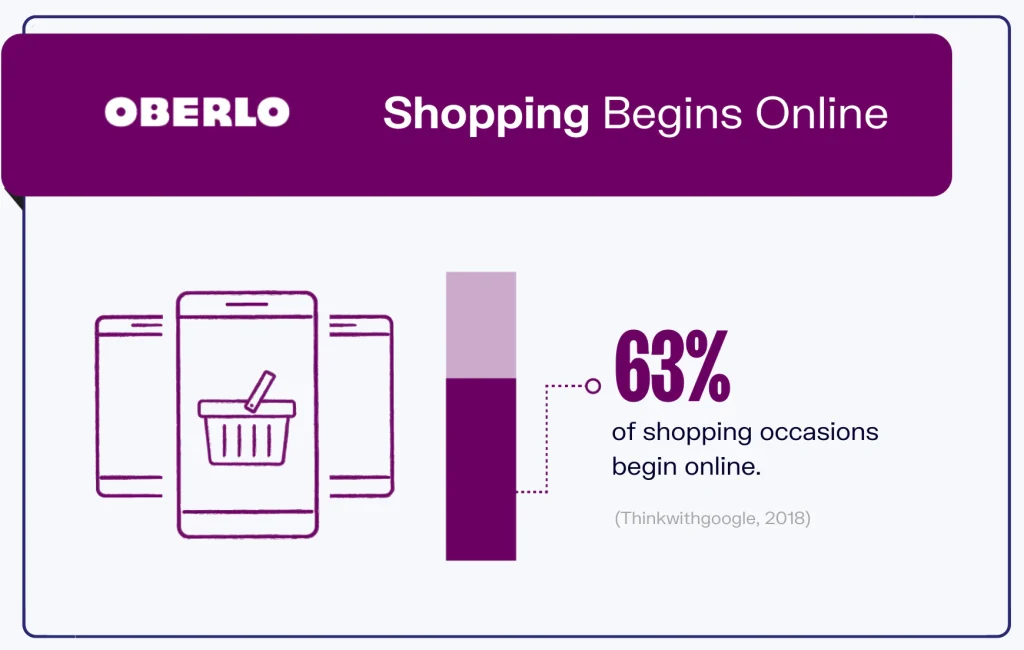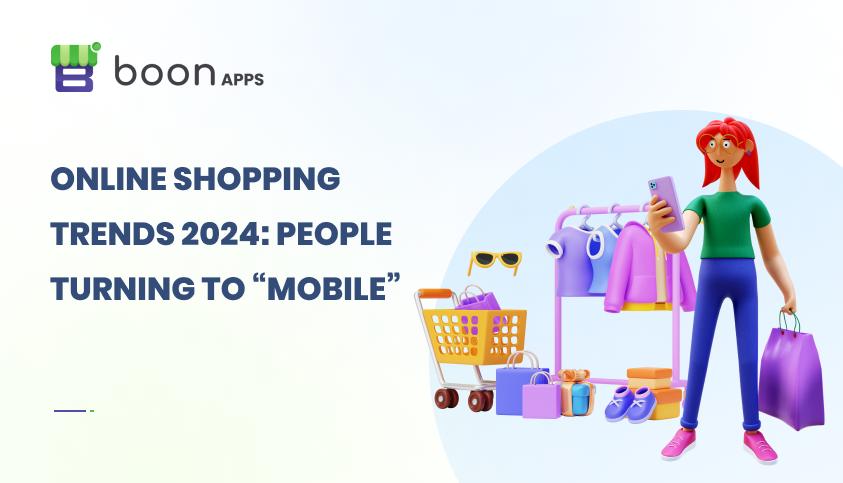In 1995, the first online order for a book was placed on Amazon.
After twenty-seven years, the eCommerce industry is set to surpass $5.5 trillion in global sales and show no downturn shortly. The increasing penetration of smartphones, wide access to the internet, and people’s inclination towards comfort are the primary reasons behind this exponential growth.
Indeed, the eCommerce market has been increasing for the last decade, but the pandemic has added fuel to this growth, and there has been a boom in online purchasing. On the other hand, businesses are also responding to this change positively and implementing various strategies to fulfil customer’s evolving requirements.
More than 1.2 billion people use their smartphones to access the internet daily. And one of the researchers has said that nearly half of the population today uses smartphones to get things done. Consequently, consumer shopping trends are also changing quickly, and brands welcome these changes with open arms to fulfil the prevailing consumer shopping trends.
So, what will the future of online shopping look like? What trend will dominate in 2024? Hold on. This blog will help you understand the online shopping trends of 2024 and how far consumer inclination towards mobile is going. Let’s discuss this in detail.
Jaw-dropping Statistics to Know about Online Shopping Trends
Online shopping has become a norm in the 21st century as people want instant gratification for everything, leading to the growth of the immense eCommerce sector.
With the benefit of ordering products online from the comfort of home, comparing prices, availing discounts, and checking reviews of products, it is no shocking anymore that online shopping has been growing by leaps and bounds.
If you are a retailer and want to boost sales and customer base, having a mobile presence has become pivotal. In this detailed blog, we will examine the latest trends in online shopping, but before that, we will have to look at exciting statistics and graphs to understand the topic better.
The most crucial mobile shopping stats include the following:
- From sending text messages to buying and ordering everything online, the eCommerce market has become worth $2.2 trillion within two decades.
- By the end of 2022, mobile commerce sales were observed to reach $3.56 billion across the globe.
- More than 71% of customers prefer voice search over messages. Hence, entrepreneurs are considering this trend in the years to come. Cooking a dinner? Don’t worry; book a cab while booking and get things done quickly.
- More than 80% of users have bought products online using their mobile devices in the past six months.
- More than 51% of users want to access mobile phones rather than web apps as they claim apps are convenient and have appealing UI.
- It was noticed that amid the Cyber Week Sale, more than half of online sales came from smartphones.
The above statistics clearly show that “mobile shopping’ is here to stay and it’s the future.
We already shop on our phones just as often, if not more, than on desktop websites or in person. There’s no reason to think that things will take a different turn down the road.
If you are running an online store but need a mobile presence, jumping on the bandwagon is high time. If you are running out of the budget and don’t want to invest a huge amount of money in app development, opt for Shopify mobile app builders and deliver an enhanced ordering experience to your customers. Because the mobile shopping market is booming, you will miss another excellent opportunity to make cash if you are still not ready to sail on this wave.
Online Shopping Trends to Watch in 2024

Source: Oberlo
From the previous section’s number and graph, it is clear that online shopping is here to stay. We have passed that “initial” stage and online shopping has become mainstream for people of all ages. From books to electric devices to clothing to home essentials, we can get almost anything delivered to our doors after clicking double taps on our mobile.
ECommerce has levelled the playing field for brands with direct-to-consumer business models that can provide an excellent online experience. However, to meet customer expectations and avoid being overtaken by more agile competitors, even businesses born into an omnichannel environment must remain one step ahead of eCommerce trends.
Please look into the trends that we believe will rule the online shopping and eCommerce world in 2024 and beyond.
Social Commerce
- Have you tried that new restaurant?
- Did you see that new smartphone ad on Instagram?
Yes, people are obsessed with social media platforms, and these channels often encourage them to buy new products. It is noticed that more than 47% of social media users buy a product they have come across on Instagram or TikTok.
Social media sites are way beyond just making friends – they are a marketplace where brands can promote their products, interact with buyers, assist them, and boost customer engagement ratio. For instance, brands are making the most out of Instagram Shops and allowing customers to buy products without leaving the app.
Social media are ushering in a new era of digital business. Businesses that use social media as a direct sales channel have access to a massive and constantly expanding client base.
Personalized Shopping Experience
- Hey Smith, your wishlist trouser is re-stocked.
- Its lunch time, let’s order something.
Yes, people more often get this kind of personalized notifications from their favourite apps. Personalized marketing strategy has been a buzzword on the Internet, and it is the only technology that encourages people to buy something quickly.
For example, shoppers can find the things they are most interested in with the help of personalized product recommendations. Customized email marketing strategies have the potential to increase conversions and engagement. Make sure each encounter with the customer feels specially designed. This holds for omnichannel experiences across in-store and online channels, as well as for current and potential customers.
Modern Technology, Modern Experience
Blockchain is becoming more than just a “buzzword” in the financial sector. It is starting to leave its mark on the online shopping sphere. Blockchain technology will be used by Google Purchasing to facilitate safe transactions, giving customers a degree of transparency and confidence that has never been seen in online purchasing.
For instance, Google Shopping is changing how people interact with it in response to the popularity of voice-activated assistants and smart speakers. Say, “Hey Google, find me the trendiest sneakers under $100,” and you’ll be presented with a carefully chosen list of options.
Superfast Doorstep Delivery
It was believed earlier that “customer” is the king, but now “convenience” is everything. Yes, customers’ inclination towards “comfort” has increased in recent years. The concept of same-day delivery enriches the customer experience, offering a delivery choice that matches seamlessly with their choices and expectations, eventually increasing the overall satisfaction levels.
However, online business owners should consider the below factors to set a new benchmark in the industry:
- Order processing and fulfilment must be done on time to satisfy delivery deadlines.
- It’s critical to effectively utilize resources when providing same-day delivery services.
- To reduce the possibility of product damage during delivery, carefully consider how things are packaged and handled during transit.
- To prevent delivery mistakes, accurate labelling is necessary. It is essential to make sure that products are accurately labelled with all relevant information, including destination data, to avoid misdelivery or other mistakes that can negatively impact the customer experience.
Renting and Reusing
“The actions of renting, and reusing, consumer goods and products rather than buying new,” according to Barclays, is called the “ReCommerce Economy.” It happens via offline or online means of distribution.
These procedures have the following definitions:
- Renting (using hired goods rather than new ones)
- Reusing (purchasing used goods)
Retailers in the UK have a great opportunity here, and they might consider making changes to give customers more economical and environmentally friendly ways to shop in the future.
For instance, Nike Refurbished launched in 2021, sourcing a mix of returns and open-box products, allowing the consumer to purchase ‘gently used’ footwear. Selfridges Rental launched in the same year. Among the many recently joined brands is Oh Polly, which just announced their dress rental service this week.
Sustainability and reusability are on the agenda of the major players, and it could pay to be on yours, too.
Buy Now, Pay Later
Sometimes, a customer is fond of products but unable to shop because of financial issues. Therefore, many online brands are introducing a concept known as “buy now, pay later” (BNPL) to overcome this issue and ensure they retain such potential buyers.
This concept allows customers to pay for their purchases in small instalments without paying vast amounts of interest. Online retailers are increasingly implementing this business model because it can
- Reduce the cart abandonment ratio
- Increase sales figures
- Make the checkout process faster
- Boost the overall order value
Adapt to the Evolving Online Shopping Industry with Emerging Trends
The combination of technology and personalized services will rule the online shopping scene in 2024. Companies that adjust and incorporate these trends into their strategic toolkit will be the ones to follow, develop, and take the lead. When it comes to innovation and client happiness, they will set the standard.
Although retail sales have long been a significant business model, the industry is still changing as a result of the growth of eCommerce. In 2024, it will be imperative that you keep an eye on your rivals and keep up with the latest developments in eCommerce.
Customers turn to mobile shopping, and this trend is here to stay. Brands and retailers need to adjust and optimize for consumers constantly since a growing percentage of consumers are selecting mobile as their preferred channel.
